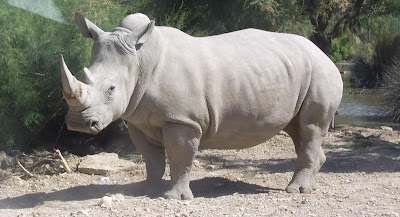 Rhinoceros also known as rhino, is a group of five extant species of odd-toed ungulates in the family Rhinocerotidae. Two of these species are native to Africa and three to southern Asia.
Rhinoceros also known as rhino, is a group of five extant species of odd-toed ungulates in the family Rhinocerotidae. Two of these species are native to Africa and three to southern Asia.The rhinoceros family is characterized by its large size (one of the largest remaining megafauna), with all of the species able to reach one tonne or more in weight; an herbivorous diet; a thick protective skin, 1.5–5 cm thick, formed from layers of collagen positioned in a lattice structure; relatively small brains for mammals this size (400–600 g); and a large horn. They generally eat leafy material, although their ability to ferment food in their hindgut allows them to subsist on more fibrous plant matter, if necessary. Unlike other perissodactyls, the African species of rhinoceros lack teeth at the front of their mouths, relying instead on their powerful premolar and molar teeth to grind up plant food.
Rhinoceros are killed by humans for their horns, which are bought and sold on the black market, and which are used by some cultures for ornamental or (largely pseudo-scientific) medicinal purposes. The horns are made of keratin, the same type of protein that makes up hair and fingernails. Both African species and the Sumatran Rhinoceros have two horns, while the Indian and Javan Rhinoceros have a single horn.
The IUCN Red List identifies three of the species as "critically endangered".
The word rhinoceros is derived through Latin from the Ancient Greek: ῥῑνόκερως, which is composed of ῥῑνο- (rhino-, "nose") and κέρας (keras, "horn"). The plural in English is rhinoceros or rhinoceroses. The collective noun for a group of rhinoceroses is crash or herd.
The five living species fall into three categories. The two African species, the White Rhinoceros and the Black Rhinoceros, diverged during the early Pliocene (about 5 million years ago) but the Dicerotini group to which they belong originated in the middle Miocene, about 14.2 million years ago. The main difference between black and white rhinos is the shape of their mouths. White rhinos have broad flat lips for grazing and black rhinos have long pointed lips for eating foliage. A popular — if unverified — theory claims that the name White Rhinoceros was actually a mistake, or rather a corruption of the word wyd ("wide" in Afrikaans), referring to their square lips.
White Rhinoceros are divided into Northern and Southern subspecies. There are two living Rhinocerotini species, the Indian Rhinoceros and the Javan Rhinoceros, which diverged from one another about 10 million years ago. The Sumatran Rhinoceros is the only surviving representative of the most primitive group, the Dicerorhinini, which emerged in the Miocene (about 20 million years b= ago). The extinct Woolly Rhinoceros of northern Europe and Asia was also a member of this tribe.
A subspecific hybrid white rhino (Ceratotherium s. simum × C. s. cottoni) was bred at the Dvůr Králové Zoo (Zoological Garden Dvur Kralove nad Labem) in the Czech Republic in 1977. Interspecific hybridisation of Black and White Rhinoceros has also been confirmed.




